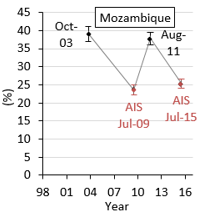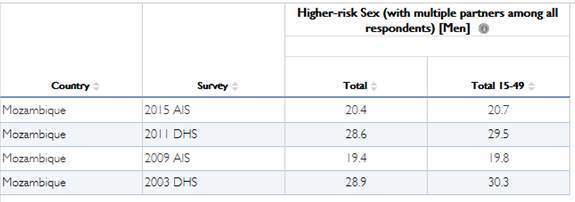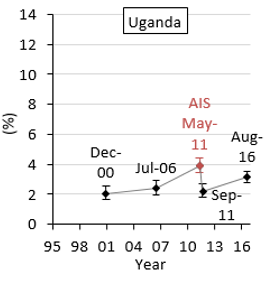Home » Countries » Other countries » Mozambique differences AIS and DHS
| Mozambique differences AIS and DHS [message #14410] |
Wed, 04 April 2018 10:17  |
 Robin
Robin
Messages: 2
Registered: April 2018
|
Member |
|
|
Hello everyone,
I'm analysing data sexual behaviour in eastern and southern Africa, using both DHS and AIS data. In Mozambique, there was an AIS in 2009, a DHS in 2011, and an AIS in 2015. I noticed that for some variables the values differ markedly between these surveys - too much to be 'real'. See the example below for reported multiple partnerships among males. I mainly found these extreme differences for multiple partnerships and types of partners (high-risk/casual) for males, but not among females and in other countries where there are both DHS and AIS.
The reports on the surveys in Mozambique give slightly different values than I have (due to slight differences in calculations) but similarly large differences between 2009, 2011, and 2015. While both AIS and DHS aim to be nationally representative and sample sizes for men are actually comparable here, can these differences be attributable to different sampling methodologies? I don't think there are differences in the questionnaire that can explain this. Or am I missing something?
Would be great to hear if someone has an explanation for this!
Thanks,
Robin
Males reporting multiple partnerships in Mozambique:

|
|
|
|
| Re: Mozambique differences AIS and DHS [message #14460 is a reply to message #14410] |
Mon, 09 April 2018 11:32   |
 Bridgette-DHS
Bridgette-DHS
Messages: 3230
Registered: February 2013
|
Senior Member |
|
|
Following is a response for Senior DHS Specialist, Joy Fishel:
Your numbers are quite a bit different from what is in STATcompiler and the reports. In our numbers, around 20% of men have multiple partners in the AIS surveys, compared with around 30% in the DHS surveys. Although the variation is smaller than you state (10 percentage pts rather than 15), it is still a little odd. Here are some possible reasons for variations across surveys.

Instruments: Across the four surveys, the questionnaires differ slightly for this section, but these differences are unlikely to produce a dramatically different estimate for multiple partners.
Sampling: Sampling strategies were similar. It is possible the differences are due to random sampling error, but with two surveys of each type and the consistent pattern across all four, this seems unlikely.
Normative response bias: It is possible that people participating in an HIV-focused survey may feel more pressure to report fewer partners since that was one of the early messages in the response to the HIV epidemic. In addition, the DHS questionnaire prior to this section is probably a little longer than the AIS questionnaire, which could allow more time to build rapport and foster more accurate reporting. We do not know of any special reason why such a reporting bias would affect Mozambique more than other countries.
To summarize, in Mozambique the AIS estimates appear to be about 10 percentage points below the DHS estimates. We cannot account for this variation.
-
 Attachment: mz-diff.bmp
Attachment: mz-diff.bmp
(Size: 340.93KB, Downloaded 914 times)
|
|
|
|
| Re: Mozambique differences AIS and DHS [message #14464 is a reply to message #14460] |
Tue, 10 April 2018 07:14  |
 Robin
Robin
Messages: 2
Registered: April 2018
|
Member |
|
|
Hi Joy,
Thanks a lot for your response!
My numbers are different from the ones published as I'm using those reporting sex in the past 12 months as the denominator rather than all who had sex before, and the graph was also produced before applying sampling weights. But, as you say, the large variation across DHS/AIS persists regardless.
One other example I found was in Uganda, also for multiple partners, for females. See figure below. This is particularly odd as the AIS and DHS were completed with only a couple of months in between. For males, the value is nearly exactly the same for both surveys.
Your explanation of response biases is plausible. Unfortunately, we can't know for sure. At least it's reassuring for me that I haven't missed anything!
Robin

-
 Attachment: Uganda.PNG
Attachment: Uganda.PNG
(Size: 17.18KB, Downloaded 859 times)
|
|
|
|
Goto Forum:
Current Time: Mon Dec 22 08:38:29 Coordinated Universal Time 2025
|